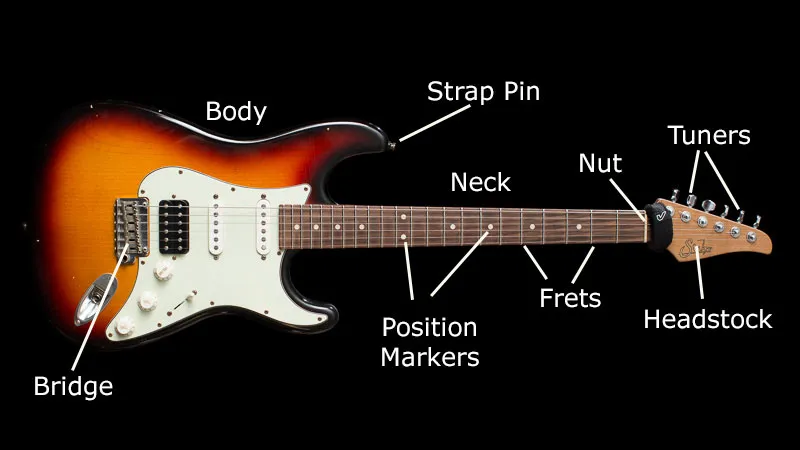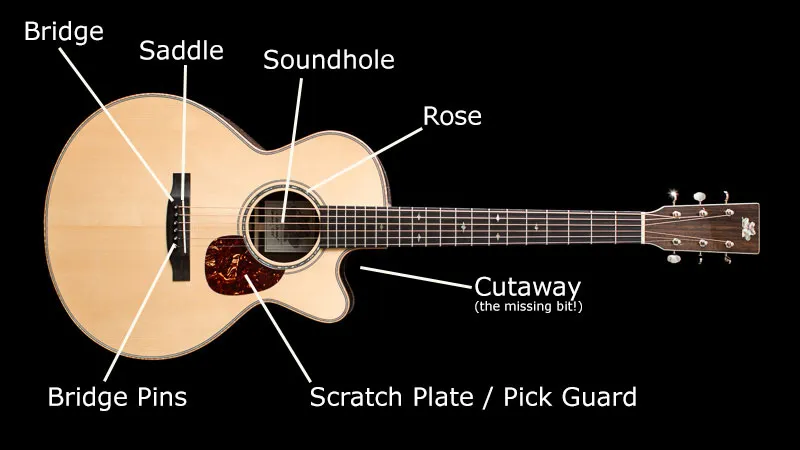
Hi Hivers,these are some of the terms you will see when people talk about guitars. I will try and add to this over time to have a complete list of guitar
Body
The main part of the guitar, where you'll find the bridge, and on electric guitars, the volume and tone knobs. This is easy to remember: the body is the bit that is in contact with your body!
Neck
The bit that pokes out of the body, which the strings run along.
Fingerboard
The part of the guitar where you place your fingers to play; the flatter side of the neck. Also called fretboard.
Headstock
The bit at the end of the neck where the strings stop and we find the tuners.
Tuners (Machine Heads)
The things that you turn to change the pitch of the strings. Usually found on the headstock.
Nut
A bone or plastic (sometimes metal) piece at the end of the fingerboard near the headstock.
Bridge
The far end of the strings from the nut, on the body of the guitar, usually metal. This is where the ‘ball' will sit when you change your strings.
Frets
Actually means the spaces in between the fretwires (the metal strips that run across the fingerboard). However, when people talk about ‘frets' – as in, “place your fingers near the frets” – they are actually referring to the fretwires. This seems to be in such common use that on this site we'll stick with ‘frets' to mean the fretwire.
Position Markers
The dots on the fretboard are a handy indicator of the 3rd, 5th, 7th and 9th frets. The 12th fret has two dots; then the pattern repeats.
Strap Pin
This is the thing that your guitar strap fits on, a kind of button. I seriously recommend getting some kind of strap lock to keep your strap firmly attached - if your guitar hits the floor when you're standing up it could be the end of your guitar!
ELECTRIC GUITAR SPECIFIC BITS

Pick-up(s)
A pickup is found under the strings of an electric guitar, and ‘picks up' the sound. They contain magnets and measure the changes of the magnetic field made by the moving strings. They come in two basic types: single coil (as found on most Fender guitars) and humbucker (found on most Gibson guitars). Humbuckers have a fatter sound and create less hum (hence the name).
Pickup Selector
Most electric guitars have more than one pickup, and the selector will allow you to choose which is being used. You can often choose to use more than one at a time. Fender Stratocasters have three pickups but have a five-way switch. Gibson Les Pauls have two pickups and a three-way switch. More on that later!
Output Jack Socket
This is where you will plug your guitar in if you use an amplifier. Make sure the cable is pushed all the way in or it will make a lot of noise!
Volume Knob(s)
Pretty obvious really: these control the volume of the electric signal of your guitar. If you've got more than one pickup, you'll usually have more than one volume knob (this is more often the case with Gibson-type guitars rather than Fenders).
Tone Knob(s)
Most guitars have one or two tone controls. These control the amount of bass (low) and treble (high) sounds that the guitar makes. Take some time to play a chord and move the tone knob so you know what it does because you really have to hear it yourself to understand it properly!
Scratchplate / Pickplate / Pickguard
Scratchplates have a couple of functions. On acoustics, they are there to protect the body and on electrics, they hold all the electronics in place and protect the wood.
‘Whammy' Bar
This is a metal bar that comes out of the bridge in some instruments and by pushing it down will lower the pitch of the notes being played. They can make your guitar go out of tune, and in my opinion are not a very useful attribute on a beginner's guitar, but they are a lot of fun and can be very expressive once you know what you are doing!
String Tree
Some guitars have a small 'tree' that the strings run under in between the nut and the tuning pegs, to keep the strings from jumping out of the nut. This isn't needed on most guitars.
You don't want one of these! If there are little round tuners on the bridge, avoid it if you are a beginner! This type of bridge system has little clamps that lock the strings in place so that they don't go out of tune if you go crazy with the whammy bar but only really useful if you are doing serious whammy bar tricks, like Steve Vai or Joe Satriani, but for the beginner they are usually a complete nightmare and many of the modern pros doing highly technical whammy bar tricks are using a regular type of bridge these days.
ACOUSTIC GUITAR SPECIFIC BITS
Most of the terms on this page apply to both electric and acoustic guitars. Here are a few which are specific to acoustics

Sound Hole
This is where the sound of the guitar will come out after it has bounced around inside! When you strum you don't want to cover this too much if you can help it!
Rose
This is just decoration around the Sound Hole.
String Peg
A string peg is a plastic (or sometimes metal) pin that holds the string in the bridge. Make sure these are pressed in firmly because there is a lot of pressure on them and they can be dangerous if they spring out. Read the lesson on Changing Acoustic Strings carefully before playing with these!
Scratch Plate / Pick Guard
On an electric guitar the scratchplate often holds the pickups and other electric bits in place, on an acoustic guitar, it does more what its name suggests and protects the wood from the pick!
Bridge
On an acoustic, the bridge is usually wood and bigger than on an electric guitar.
Saddle
This is what the string sits on in the bridge, usually bone or plastic.
Cutaway
On the lower side of the body, there is sometimes a 'cutaway' which allows easier access to the upper frets - not something beginners should be too worried about - it'll be a while before you get 'up the dusty end....
Hope,this helps
